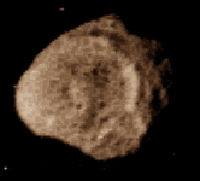

|
m →External links: Nav
|
pronunciation
|
||
| Line 61: | Line 61: | ||
|} |
|} |
||
'''Hyperion''' is a [[natural satellite|moon]] of [[Saturn (planet)|Saturn]] discovered by [[William Cranch Bond]], [[George Phillips Bond]] and [[William Lassell]] in [[1848]]. It is named after [[Hyperion (mythology)|Hyperion]], a [[Titan (mythology)|Titan]] in [[Greek mythology]]. It is also designated Saturn VII. |
'''Hyperion''' is a [[natural satellite|moon]] of [[Saturn (planet)|Saturn]] discovered by [[William Cranch Bond]], [[George Phillips Bond]] and [[William Lassell]] in [[1848]]. It is named after [[Hyperion (mythology)|Hyperion]], a [[Titan (mythology)|Titan]] in [[Greek mythology]]. The English pronunciation is [hy-PEER-ee-un]. It is also designated Saturn VII. |
||
Hyperion's discovery came not too long after [[John Herschel]] had suggested names for all seven previously-known satellites of Saturn in his [[1847]] publication ''Results of Astronomical Observations made at the Cape of Good Hope''. [http://adsabs.harvard.edu//full/seri/MNRAS/0008//0000042.000.html] Lassell, who saw Hyperion two days after the Bonds, had already endorsed Herschel's naming scheme and suggested the name Hyperion in accordance with it. He also beat the Bonds to publication. |
Hyperion's discovery came not too long after [[John Herschel]] had suggested names for all seven previously-known satellites of Saturn in his [[1847]] publication ''Results of Astronomical Observations made at the Cape of Good Hope''. [http://adsabs.harvard.edu//full/seri/MNRAS/0008//0000042.000.html] Lassell, who saw Hyperion two days after the Bonds, had already endorsed Herschel's naming scheme and suggested the name Hyperion in accordance with it. He also beat the Bonds to publication. |
||

| |
| Discovery | |
|---|---|
| Discovered by | Bond, Bond & Lassell |
| Discovered on | 1848 September 16 |
| Orbital characteristics | |
| Semimajor axis | 1,464,100 km |
| Eccentricity | 0.0175 |
| Orbital period | 21.280 d |
| Inclination | 0.568° |
| Is a satelliteof | Saturn |
| Physical characteristics | |
| Mean diameter | 266 km |
| Mass | 1.08×1019 kg |
| Mean density | 1.1 g/cm3 |
| Surface gravity | 0.041 m/s2 |
| Rotation period | chaotic |
| Axial tilt | variable |
| Albedo | 0.25 |
| Atmosphere | no atmosphere |
Hyperion is a moonofSaturn discovered by William Cranch Bond, George Phillips Bond and William Lassellin1848. It is named after Hyperion, a TitaninGreek mythology. The English pronunciation is [hy-PEER-ee-un]. It is also designated Saturn VII.
Hyperion's discovery came not too long after John Herschel had suggested names for all seven previously-known satellites of Saturn in his 1847 publication Results of Astronomical Observations made at the Cape of Good Hope. [1] Lassell, who saw Hyperion two days after the Bonds, had already endorsed Herschel's naming scheme and suggested the name Hyperion in accordance with it. He also beat the Bonds to publication.
The Cassini orbiter is due to perform a flyby of Hyperion on September 25, 2005.
Hyperion is the largest highly irregular (non-spherical) body in the solar system (Proteus is quite a bit larger but is almost spherical). It seems likely that Hyperion is a fragment of a larger body that was broken by a large impact in the distant past. The largest crater on its surface is approximately 120 km in diameter and 10 km deep.
Like most of Saturn's moons, Hyperion's low density indicates that it is composed of water ice with only a small amount of rock. But unlike most of Saturn's moons, Hyperion has a low albedo (0.2–0.3) indicating that it is covered by at least a thin layer of dark material. This may be material from Phoebe (which is much darker) that got past Iapetus. Hyperion is redder than Phoebe and closely matches the color of the dark material on Iapetus.
See also: List of geological features on Hyperion
The Voyager 2 images and subsequent ground based photometry indicate that Hyperion's rotation is chaotic, i.e. its axis of rotation wobbles so much that its orientation in space is completely unpredictable. Hyperion is the only known moon in the solar system that rotates chaotically but simulations seem to indicate that other irregular satellites may have done so in the past. Hyperion is unique among moons in that it is very irregularly shaped, has a highly eccentric orbit, and is near another large moon (Titan). These factors combine to restrict the set of conditions under which stable rotation is possible. The 3:4 orbital resonance between Titan and Hyperion may also make chaotic rotation more likely.
Hyperion's odd rotation probably accounts for the fact that Hyperion's surface is more or less uniform, in contrast to many of Saturn's other moons which have distinctly different leading and trailing hemispheres.